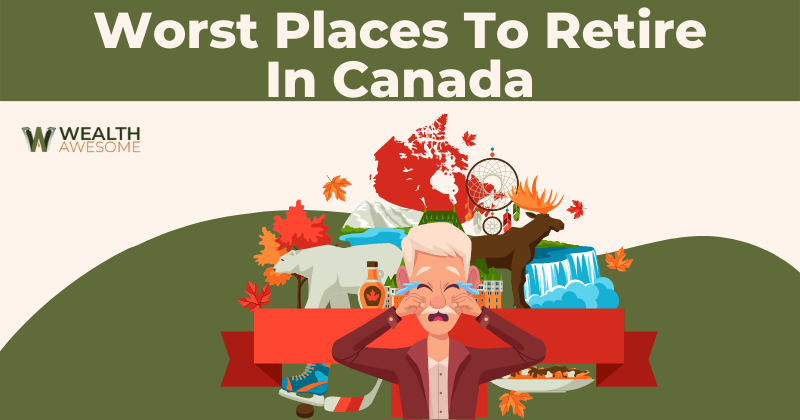Ah, retirement. Gone are the days of waking up early, sitting in traffic, and hitting deadlines. Instead, your days can be wide open or filled with golf, friends, and casual dinners.
If you have big plans for your retirement, you need to make sure you live in a city to fit all your needs. Not only do you want to feel safe, but you want to be aware of the weather and all the amenities your city has to offer.
With that in mind, I helped you take some of the guesswork out of where NOT to retire. Whether due to crime rates, gloomy weather, or poor air quality, the following cities just aren’t a retiree’s dream. Read on to find out more about the worst places to retire in Canada.
What Makes It the Worst?
Canada is known for its high standard of living and beautiful landscapes. But every country has certain cities that aren’t up to par with the rest. Canada is no different.
The following factors helped me shape my decision on the worst places for retirees.
Crime
No one wants to spend their retirement years fearing for their safety. While Canada is generally a safe country, some parts have increased crime rates.
Many of these areas also show high unemployment rates and limited employment opportunities, which can account for the crime increase.
Weather
If you’ve lived in Canada for your whole life, you’re probably used to the weather swings throughout the year. However, once you’re retired, you might become more outdoorsy.
But those dreams could be dashed if you live in a place with lots of rainfall, cloud cover, and extremely cold temperatures.
Pollution
Poor air quality can put a damper on the nicest city. If you’re planning on spending extra time outdoors during your retirement, make sure you’re aware of how clean the air is around you.
Industrial plants may provide job opportunities for nearby residents, but they can also cause the air to stink and pollution to rise.
Limited Amenities and Things To Do
You’re retired! No more slaving away at the 9 to 5. It’s time to live the good life. But you might be out of luck if you choose to retire to a city with limited entertainment options.
Before you make your decision, consider what you want out of retirement – dinner dates, movie or theatre options, museums?
If that’s high up on your list, moving to a small, remote city isn’t going to make you happy.
Worst Places To Retire
The following list considers the above factors and might make you think twice about living in these places during your retirement.
Of course, before you retire and move, you should do your own homework about your desired location and make sure it fits in with your wants and needs.
1. North Battleford, SK

Weather: Average Max Temperature – January: -10°C, July: 24°C
Crime rate: Based on the Crime Severity Index (CSI) – 437.70 – 4th in CSI rankings of over 10,000
Amenities: Although the city has a population of about 14,000, it does have public transportation, an arena for the Junion Ice Hockey League, and a Performing Arts Center.
Air quality: Good based on IQAIR.
North Battleford makes the list because of its crime index. The city comes in at number four on the list but what makes it concerning is that it had a 46.87% increase in violent crimes in 2019.
The city consistently ranks on the list as one of the most dangerous. Many crimes are due to social issues like poverty, addiction, and mental illness. There’s also a growing gang population and severe racial divisions.
The city tries its best to limit crime. There’s been an increase in lighting throughout former dim parks and sidewalks.
Property owners in the downtown can now face tax increases for leaving areas vacant or get incentives to perform improvements.
There’s also a bigger focus on social programs. A homeless shelter was opened, along with a rooming house that helps those frequently in contact with police.
Youth programs began to help sway targeted at-risk young men and women from joining gangs.
While that’s a step in the right direction, the city still has a long way to go. If you’re looking to retire, you might want to skip North Battleford.
2. Thompson, Manitoba

Weather: Average Max Temperature – January: -25°C, July: 24°C
Crime Rate: Most violent city with a violent CSI of 570, the average is 82.
Amenities: Thompson is an eight-hour drive from Winnipeg. Once coined the “Hub of the North,” the city is a great stop for the outdoor enthusiast but doesn’t offer much else in terms of entertainment.
Air quality: Good per IQAir
Thompson, Manitoba, is off the beaten path. It’s a perfect spot for those that love the outdoors – there are lots of parks nearby for hiking and other adventurous activities.
However, if you’re thinking this is the retiree’s dream, you might want to think again.
Thompson is one of the most dangerous cities in Canada. It’s one of the areas with the highest crime rate. Because it is a “hub” city, it’s a common place for drug trafficking and other criminal activities.
If that isn’t reason enough, Thompson also doesn’t have the best weather. Residents of the town endure long cold winters, with the lowest temps regularly hovering around -25°C. Snow can fall as early as October and last until May.
Aside from that, Thompson isn’t really a bustling metropolis. There aren’t many cultural attractions or other amenities you may be looking for as a retiree.
Overall, if Thompson is on your list to check out, you might want to cross it off.
3. Sarnia, Ontario

Weather: Average Max Temperature – January: -7°C, July: 25°C
Crime Rate: 82 per the CSI.
Amenities: Sarnia has many outdoor parks and recreational facilities. With over 71,000 residents, you can find many artsy and cultural opportunities available throughout the city.
Air quality: Poor air quality because the city is near many industrial complexes.
Sarnia has a decent cost of living and enough amenities to keep any retiree busy. However, the city made the list because of its air quality.
Located just south of the downtown area is a slew of refining and chemical companies dubbed “Chemical Valley.”
While the area is crucial to the surrounding economy, it’s also a big pollutant. The Global News uncovered information that puts the cancer-causing chemical benzene up to 44 times above its annual level throughout the region.
To top that off, you’ll have a view of unsightly factories and refineries. Combine that with the smell of asphalt, gasoline, and rotten eggs, and you’ll feel sick to your stomach most days.
Current residents are concerned about the health problems these pollutants create.
Many families are dealing with asthma and other respiratory concerns, as well as cancer and other health issues.
4. St. John’s, Newfoundland

Weather: Average Max Temperature – January: -5°C, July: 19°C
Crime Rate: 88.9 per CSI.
Amenities: A tourist center and cultural hub, the city offers residents and visitors a range of museums, art galleries, restaurants, and boutiques.
Air quality: Good
St. John’s is a picturesque coastal town with a vibrant community and cultural hub full of tourism. So, why would such a city be on this list? There really is only one reason, and that’s the weather.
St. John’s is the easternmost city in all of North America, and because of this, the weather isn’t exactly the best. In fact, most Canadians and residents of the town know that it’s the windiest, foggiest, and cloudiest city in all of Canada.
You won’t find much sunshine in this part of the country, and the dreary wintery days can last long into May, sometimes even June.
If you’re a retiree who loves the outdoors, you might find St. John’s an attractive option for all it has to offer but may need to think twice when considering its dismal weather.
5. Dolbeau-Mistassini, Quebec

Weather: Average Max Temperature – January: -12°C, July: 24°C
Crime Rate: 73 per CSI
Amenities: The area is near several rivers and Lac-Saint-Jean, so be prepared for plenty of outdoor activities.
Air quality: Good
The city formed back in 1997 when two separate cities, Dolbeau and Mistassini, combined. They are separated by the Mistassini River.
Despite being located in northern Quebec, the climate is similar to cities located in the southern part of the province.
However, the reason Dolbeau-Mistassini is on the list is twofold. Because it’s a nearly six-hour drive from Montreal, the city is isolated from the rest of the country.
As a retiree, you may not find the amenities you’re hoping for in this area. It is also a long journey to any larger nearby cities.
Dolbeau-Mistassini was known for a paper mill that shut down but recently reopened. However, it’s also the cause of much of the pollution and stink around town.
While it’s certainly a good area for outdoor enthusiasts, its northern location makes it far from other cities and a remote location most retirees don’t picture when thinking about their golden years.
The most unfriendly cities in Canada for retirees
While unfriendliness is a hard factor to quantify, here are some takes on this. North Battleford, SK, with its high crime rate; Thompson, Manitoba, known for its isolation and high crime; and Sarnia, Ontario, which faces challenges with air quality due to nearby industrial complexes, are a few examples of some unfriendly factors that could lead to higher isolation.
The least affordable places to retire in Canada
Affordability is a significant factor when choosing a retirement destination. In Canada, cities like Vancouver and Toronto are consistently ranked among the most expensive, with high housing costs and elevated living expenses.
Also, places like Victoria in British Columbia and Kelowna in the Okanagan Valley have seen increasing property values and living costs, making them potentially less affordable for retirees on a fixed income. So although these are highly sought after destinations, they could be considered the “worst” cities to retire in terms of affordaility.
Conclusion

Your retirement should be a special time spent in a location you’ve always dreamed of, doing activities you love.
While Canada can provide ample opportunities for retirees, some locations aren’t so desirable.
Before you decide on a retirement destination, do your homework and make sure you look at all the facts. Visit at different times of the year so you can get the whole picture – your viewpoint can change as quickly as the seasons.
If you need some help deciding on a retirement location, check out these top places to spend your golden years.




